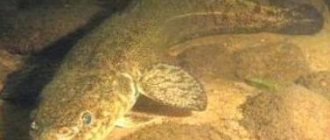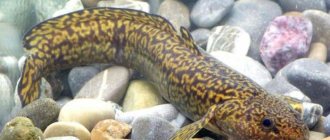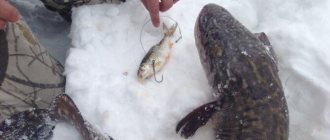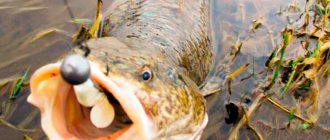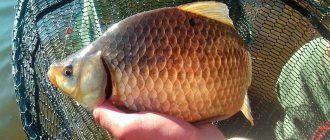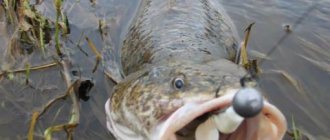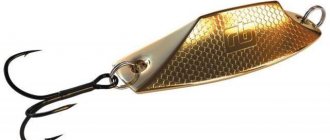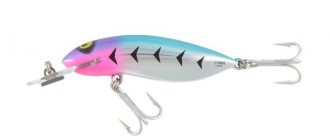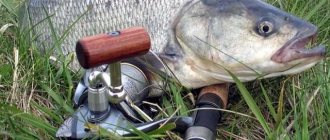Burbot differs from other freshwater fish not only in appearance, but also in its way of life. Only some anglers catch it purposefully, while others don’t even try to do it. The reasons are different. Some people don’t know anything about it and consider it the most mysterious inhabitant of water bodies. Others call it a slippery snake that doesn’t look like a fish at all. And it’s completely in vain, because its meat is tender, slightly sweet, and tastes like lobster, and this, as you know, is a very expensive delicacy. In addition, catching burbot brings a lot of pleasure. Here the fisherman has the opportunity to show all his qualities: to find, outwit and pull a big, strong fish ashore.
Depending on weather conditions, burbot may begin to bite in mid-summer or closer to autumn. At this time, his bites are still random. Most often, it is caught on inclement days on bottom gear, which fishermen use to catch bream, silver bream and roach. If this happens repeatedly, you can be absolutely sure: the burbot likes this part of the reservoir, and it will not leave here until spawning. It is advisable to remember such places. With the arrival of real autumn, when the water cools down to 15-17 degrees, they will be very promising for catching the handsome spotted fish. It begins to be caught quite well already in October, and the peak of activity is observed approximately 3 weeks before freeze-up.
Many anglers who are lucky enough to catch this fish in the fall draw hasty conclusions. They say that catching burbot is too easy. Actually this is not true. Yes, this kind of fishing is not particularly difficult, throw out the gear and wait for a bite. But for this to happen, the burbot must first be found, and this is not as easy as it might seem.
Tackle for catching burbot in spring
Photo 2. Spring burbot.
In the fishing world, it is generally accepted that catching burbot in the spring, and indeed at any other time of the year, is possible only with a donk. I can only agree that the donka is the most popular tackle for burbot fishing, but by no means the only one. Recently, a new direction has emerged - jig, and it is very promising, contrary to all skeptical expectations. But first things first.
Bottom fishing rod
Its design is not particularly important. This can be the simplest zakidushka, which is tied to a stick stuck into the bank or a coastal bush.
In the old days, in the spring, burbot was caught using simple gear, and even preschool children did this. My grandfather, whose childhood was spent in the outback of the village, on the banks of one of the tributaries of the Chusovaya, while still a boy, successfully hunted burbot for a simple snack. It was assembled from scrap materials - it was not a pity to tear it apart. Rope scaffolding, forged hook made of a nail, pebble. No bell - the gear was installed in the evening and checked in the morning. A small fish served as bait. Grandfather became keen on catching burbot quickly, and often brought home a fish whose head lay on his shoulder, and its tail dragged along the ground.
You can use feeder gear, or a spinning rod - all this is also great for catching spring burbot. Nevertheless, I give preference to zakidushki - for their simplicity, and for the ability to carry them fishing in “packs”.
Equipment device
To catch burbot on a donk, you don’t need particularly sophisticated equipment, however, there is one small nuance associated with the characteristic bite of this fish.
The burbot grabs the bait quietly and does not stand on ceremony with it for a long time - it swallows it almost immediately. Therefore, it often turns out that the bell begins to ring only when the fish has condemned the bait and gone home. The fisherman pulls the burbot ashore and fiddles for a long, long time to remove the swallowed hook, but in the end gives up on this matter - he cuts off the leash and attaches a new one.
To eliminate this unnecessary hassle, the equipment should be mounted with the ability to quickly change leads.
Rice. 1. Equipment for bottom fishing for burbot: 1 - clasp, 2 - swivel, 3 - leash, 4 - clasp for hook, 5 - hook.
However, it is advisable to use a tungsten leader.
If a hook with a burbot that has bitten is left unattended for a long time, the fish has some chance of grinding the line with its small teeth (even if it doesn’t grind it, it will ruin it). I know two such cases that happened to fishermen I knew. On top of everything else, if you are fishing with live bait, you must definitely install a tungsten leash, because no matter what the hour is, even a pike may bite.
It is best to use an elongated teardrop-shaped sinker - it is more difficult to catch in the rocks. The mass is chosen so that it is easier to cast and so that it does not get carried away by the current. 100 grams is enough.
Now about the parameters of the fishing line. It all depends on what kind of “monsters” are found in the place where you are fishing, but you should not use a very thin fishing line for equipment - the burbot is absolutely indifferent to its thickness. The most popular option for the Ural rivers:
- Main line: 0.5 mm;
- Sinker line: 0.3 mm (in case it gets stuck in the rocks - so as not to lose the leash with the hook);
- Leash: 0.3 mm (the part between the main line and the clasp).
Regarding the length. Fishing will be carried out in the coastal zone, so it makes no sense to spend a lot of fishing line on tackle. Usually 15-20 meters is enough for the eyes.
The burbot has a large mouth, so you shouldn’t waste time with hooks. I usually tie a hook of number 8 according to the Soviet classification; it is quite possible to use larger ones - up to number 10. It is advisable to have a longer forend - such a hook will be easier to pull out from the depths of the burbot throat.
Spinning (jig)
This type of burbot fishing is relatively new, and has not yet gained the required number of fans to be considered widespread. It's more exotic. Nevertheless, specialists who have mastered it are very good at carrying fish, including in spring water.
This method is not suitable for any river or terrain. Since we are dealing with a spinning rod and purely bottom-dwelling fish, it means we can only fish where the likelihood of a hook is excluded. Therefore, we will have to look for clean, pebble or sandy places, where the bottom is more or less smooth, without snags and other objects, where we can plant bait.
Standard stepped wiring will not work here either, burbot is not a pike perch or a pike perch, and it will not chase a fast bait (let alone rise after it). Therefore, they carry it out so that it “crawls” along the bottom - with the smallest steps (no higher than 20 cm), slowly. The noise made by the bait perfectly attracts fish. Here you have to “play” more with a rod than with a reel.
What to use as a “nozzle” - twisters or vibrating tails? As practice has shown, there is not much difference. However, some fishermen claim that silicone with attractants (so-called “edible rubber”) works much better than regular silicone.
Catching burbot with a jig is usually done at dusk - in the evening or in the morning, while it is still possible to control the cast visually. Some extreme sports enthusiasts also practice this in pitch darkness. But in my opinion, it’s better to spend a cold spring night by the fire, and entrust the catching of fish to the “automation” - the snookers.
What precedes successful burbot fishing in winter?
Fishermen by nature are divided into three categories:
- “Podzhopniks” who, due to their laziness or unwillingness to work, look for places where other fishermen are concentrated and simply join them.
- Those who found themselves in a new place for the first time. Often this group does not behave differently from the first. This is forgivable, but sometimes annoying. Less often, with a sense of pride and an indication of belonging to a cohort of true fishermen, they may look towards their colleagues, but try to find their fish on their own. I can confidently state that they are respected people. It’s not a pity to share knowledge and skills with such people.
- Local. These are fishermen who have repeatedly visited the area and have knowledge about promising spots, food habits and fish release hours, and other necessary information.
You already understand why I had to approach from afar the disclosure of the “secret” of the local contingent of fishermen. They live nearby, spend a lot of time fishing and even in the “wet” water they notice promising spots for fishing. Therefore, finding burbot in winter is not particularly difficult for them.
In summer
Periodic summer forays into supposed “winter” places are a good thing. You can thoroughly explore the coastline and the nearest water area. Obtain information about the relief, bottom soil, vegetation. Note for yourself in your observation diary such characteristics of the river as the strength of the current, sections of reverse flows. In general, find and collect information that will be hidden under a layer of ice and snow in winter.
For example, one of the points when catching burbot was an artificial dam and, which turned out to be open after the construction of a hydroelectric power station, a raised bottom. In the photo below, I have marked the most promising sections of the selected location of the Angara River, where in winter it is easy to find a stopover or a burbot run.
As you can see, these are calm backwaters, protected from the current by relief hills. There are also areas between the streams of water with deep, relative to the surrounding, holes.
It is at these points that burbot prefers to be during its winter movements. The bottom here is sandy and rocky. Vegetation grows only in summer. In winter it is distributed in islands.
Unfortunately, I didn’t bother to photograph the coastline, but if you turn your back to the nearest drawn oval, there is a small bay. Somewhat deep, with a thick layer of silt.
It is often recommended to stay away from such places. Apparently the burbot avoids the muddy bottom. However, I can assure you that this is not the case. The thing is that it is in these bottom sediments of organic matter that one of the burbot’s favorite snacks lives - the lamprey, or “seven-hole”. We mistakenly call it “loach”. I won’t say that lamprey is the best bait for catching burbot, but it’s definitely worth having a small supply of this animal.
An undeniable advantage is the interest of small fish in invertebrates living in muddy sediments. For burbot, running in and finding a set lunch in winter is definitely promising.
This concerns those landmarks that are worth noticing on the river in the summer. However, the short-term autumn (in principle, the “short-term period” is different in different regions) allows you to decide on winter forays for burbot.
in autumn
Autumn, especially late autumn, has long been recognized as the best season for catching burbot with donk and zakidushki.
I have already described my method of arranging trinkets along the shore (here). I assure you that the method is effective. So, bottom rigs are definitely a successful way to find burbot and take advantage of its conservatism in winter.
The fact is that there are two forms of burbot on the river:
- A local who leads a sedentary lifestyle.
- “Newcomer”, which makes quite long migrations across the reservoir in the pre-spawning period and after it.
By the way, talk about the “burbot trail,” which some fishermen regard as a myth, is connected precisely with the migratory movement of fish going to spawn. It is for this reason that the assertion that if you find a burbot trail, you can be sure of a positive result in all future fishing trips is not unfounded. Spawning migration is a complex and long-term process.
However, one should not take the burbot trail as some kind of narrow corridor at the bottom of the river. This is somewhat wrong.
If we are talking about catching burbot in a small river, then this idea is completely justified.
For example, the mouth of one of the rivers flowing into the Angara is a narrow channel.
Here, in late autumn, burbot can be found, but only for a short time. Yes, and I catch it on a spinning rod converted for donka.
On the large burbot river, the trail is a fairly wide walking section of more than tens of meters. And the fact that this move has existed for a long time is not a myth. It can shift to one side or narrow in response to fluctuations in conditions (for example, the release of water from a hydroelectric power station or its retention), but the complete cessation of the existence of the trail will be associated only with irreversible negative factors.
Now let’s summarize and identify landmarks that you should pay attention to in open water:
- Sections of the river with natural and artificial obstacles (dams, rubble), where a reverse flow is created.
- Bottom areas with depth differences. This is a classic.
- The bends and turns of the river bed.
- Bays.
- Places of confluence of streams and tributaries.
- Areas of the coast where work was carried out with bottom soil (washing sand, gravel). Usually there are many man-made dams and underwater quarries. Such places are replete with deep holes. Potential food for burbot loves such places, which means the presence of a predator is guaranteed.
- Flooded barges, reinforced concrete blocks and similar “legacies” of man.
- Rocky placers at the bottom, sandstone, low but dense vegetation alternating with open areas of the bottom.
Nozzles
There aren't many options here.
Zywiec
In principle, any linen or some other small item will do (even burbot fry). However, in the spring it is easiest to catch the following fish: gudgeon, perch, ruff or roach.
Rice. 2. Methods of attaching live bait: at the top - under the dorsal fin, at the bottom - behind the upper lip.
The live bait is simply hooked onto a hook - either by the back, or by the upper lip, or by the tail. But you can plant it so that it does not get injured. To do this, insert the shank of the hook into the mouth and remove it through the gill slit, then attach it to the leash (that’s why the hook clasp is installed on the rig).
Rice. 3. Method of inserting live bait through the gill slit.
The advantage of this bait compared to others is that the bait does not lie on the bottom, but moves quite actively, attracting fish not only by smell, but also by vibrations. It can also provoke other predators to bite, for example, chub or pike.
When choosing live bait, it is better to use bottom fish - gudgeon or ruff. They are the natural food of burbot, and (according to some observations) he likes them more. Other fish are also suitable, but you should take into account the fact that burbot does not rise above 20 centimeters from the bottom, and live bait may well float higher. Therefore, with perch, roach and other “non-bottom” live bait, it is better to attach additional weights to the rig’s leashes, and thereby limit the “height” to which the bait can rise.
Dead fish
However, the burbot is absolutely indifferent to what kind of bait is put on the hook - live or not. That is why the dead fish is a very versatile bait option for catching burbot in the spring. The good thing is that it can be prepared in advance - even during the freeze-up period. The fish is frozen and stored in the freezer.
There is another way to get this bait, used when it was not possible to catch small things. Its name is “grocery store.” Freshly frozen sprat, capelin or anchovy - according to experts, works quite well for burbot.
Photo 3. Sprat is an alternative to river fish when catching burbot in the spring.
When using dead fish, it is recommended to cut it in half. It is believed that the smell of meat and entrails reaches the burbot better than the smell of the fish itself, and attracts it more strongly.
Piece of fish meat
Photo 4. Pangasius fillet - as a bait option.
It could be bream, crucian carp or carp - either caught or bought in a store. Maybe pollock, mackerel, pangasius or herring (unsalted, of course). However, there are persistent rumors among fishermen that burbot prefers freshwater fish.
The meat is cut into strips - preferably with the skin on (to keep it on the hook more firmly). It should be planted so that the sting barely sticks out of the flesh. This reduces the chance that the fish will prick ahead of time and spit out the bait, but despite all this, the possibility of self-hooking remains.
Earth or dung worms
Photo 5. Earthworm is a delicacy for spring burbot.
In the spring it is easier to get them from compost heaps. On many rivers, burbot love the worm in the spring, but I strongly recommend using it only as an additional bait on a two-lead rig - together with fry or fish meat, because the worms are often eaten by small things, but the meat or live bait remains.
As for how to plant it, there are two options. If only a burbot bite is likely in the fishing spot, then it’s better not to be greedy - take half a dozen worms and just dress them in a bunch (so that the smell of the bait is stronger). If another fish can bite (for example, an ide or a chub), then you should put on a couple of fewer worms, and at the same time more compact - piercing them in several places. The burbot will still find the bait, but if the bycatch bites, then its chance of getting caught will be slightly higher than with a large bunch of worms.
Frog
Regarding the frog (not to be confused with a toad!), I will say this: on the Internet, opinions about it are divided. Some fishermen actively “advertise” it as the best bait for catching burbot in the spring, while some, on the contrary, categorically do not recommend it (according to them, burbot generally bypasses the frog). Most likely, this has to do with a specific area. In some places burbot is used to eating this type of food, but in others it prefers something else.
Photo 6. In fact, this is not a frog, but a toad. Its photo is given for a reason - it is completely unsuitable as a bait for burbot.
In our area, as far as I know, no one catches frogs, but not even because they are not interested in burbot. The Ural spring is known for its slowness; it gets warm quite late here, so frogs usually appear when the burbot bite is already beginning to subside. On top of everything else, all of them, barely waking up from the winter torpor, gather in swamps, lakes and large puddles, where they hold concerts. Few people would want to climb through the mud for frogs.
Rice. 4. Methods of attaching the frog: on the left - by both lips, on the right - by the back.
Usually medium-sized frogs are used.
Other attachments
These include:
- Crayfish meat, peeled from the shell. But the question arises: where to get it in the spring? Probably, this attachment can be replaced with “store-bought” shrimp. But isn't it easier to buy the same chilled fish? It is several times cheaper and will certainly be more catchy.
- Cotton wool soaked in melted butter. Yes, people practice this too. It is believed that this attachment imitates the previous one. Fishermen who have tried it assure that it works.
- Fresh chicken, beef or pork. There is information that burbot also like this bait, moreover, at times it works better than pieces of fish. In addition to meat, you can also use offal, for example, chicken liver.
Above, we examined the use of baits for catching burbot in the spring separately, but nothing prevents us from experimenting with fishing and putting a “sandwich” of two different baits on the hook. It is very likely that such a “duet” will attract burbot better than each component separately.
A few words about what not to hook
From time to time, in fishing literature and online sources there are suggestions to catch burbot using spoiled bait - rotten fish or meat. I’ll say right away - bullshit. Anyone who decided to feed burbot rotten meat is clearly consuming something wrong, and clearly went too far with it - before coming up with this heresy!
Although burbot is inclined to eat carrion, it is more or less fresh. He will never eat spoiled fish or meat . After all, this fish is an active predator, not a gatherer.
Conclusion: the bait should be as fresh as possible.
What do burbot bite on?
The main bait for burbot is a large bunch of worms.
The following baits work:
- fresh chicken liver;
- goby, gudgeon, both alive and dead;
- dead fish;
- fish tripe.
When fishing with dead fish, they must be cut across, along with the head.
The bait can be treated with an attractant, such as worm extract, mussel extract, fish oil and Asian fish sauce work well. You can either spray them onto the bait or put the bait there for a couple of hours.
If you don't have fish from your local pond, try fish from the supermarket, such as a piece of herring, or any other fish. They need to be cut into large pieces.
Use fresh fish; although burbot can be caught with stale fish, it is, in my opinion, bad, especially if there is a sufficient food supply in the reservoir.
If you use a feeder instead of a weight, there is no point in pouring any bait into it.
Place a foam sponge soaked in a mixture of attractants from the list above; it will attract him, since these fish have a well-developed sense of smell. The smell spreads quickly in the water and attracts migrating predators even from great distances.
The best bite for burbot is before and after spawning. Depending on the region, their spawning begins from November to March.
In each region, the spawning period is different, and in winter there is a ban during these periods; check it in the Fishing Rules to avoid problems with the law.
At this time, males gather in the shallows, near the coastline and actively feed. Closer to spawning, females come to these places. In such places you can find both large burbot and quite small ones, so the tackle must be ready to cope with a trophy specimen.
We recommend: Fishing for perch in winter, tips on where to look and what to fish for
After spawning, they go to places with the main current and begin to descend to the depths, to places where they will spend the warm season. Before this, they also actively fatten up.
Where to look for burbot in spring?
Burbot is found not only in running watercourses, but also in some reservoir ponds and lakes. The main conditions for it are clean and cold water (especially in the summer). In forest rivers fed by taiga tributaries and icy springs, burbot is common, as well as in small ponds built on fast, cold rivers. In some mountain and northern lakes, where even in summer the water remains icy, burbot is not only found in abundance, but is also active virtually all year round.
Large, medium and “largest” small rivers
In principle, catching burbot in the spring is possible in any place convenient for approaching the water and casting a donkey, where there is a sandy, pebble, rocky or clay-rocky bottom. The fish are now actively wandering, moving in search of food. However, there is a rule that should be taken into account first.
Scientists from ichthyology unanimously declare: burbot spends the day and rests in the depths, but always goes to shallow water to feed.
From this we can draw the following conclusion: we will have to look for places where there are shoals bordering pits. But this primarily concerns those watercourses where the difference in depth is quite distinct, these are large, medium and some small rivers.
The smallest rivers and “large” streams
On very small rivers and streams [1] Usually the food supply of small watercourses is quite poor, therefore the burbot in them forms a slow-growing dwarf form. The depths are shallow everywhere. You can catch burbot here anywhere, even on the shallowest – “knee-deep” rifts. But special close attention should be paid to the following places:
- Areas near the mouths of tributaries;
- Rocky and pebble shallows;
- Places behind spits and islands, large rocks, trees that have fallen into the water and other obstacles;
- Yamam, in particular - with snag;
- Points on the border of the main stream and quiet water;
It has been noticed that especially large burbots love to hunt in small rivers.
There are a number of indirect signs by which one can determine whether burbot is found in a particular watercourse. And this is not only the presence of current, water temperature and the nature of the bottom. If there are crayfish, minnows and especially sculpin in the river, there is a very high probability that burbot will also be in it.
Stagnant bodies of water
In forest ponds built on taiga streams, burbot almost always reaches noticeably larger sizes than its stream counterparts, because the food supply in such ponds is an order of magnitude better than in the river. In such places, it should be caught where the main tributary, or more or less full-flowing secondary tributaries, flow into the pond.
Fishing on a drain can show very good results. It has been noticed that burbot like to stand under dams, and sometimes they bite there much better than in the reservoir itself.
The same applies to large reservoirs, although not all of them contain burbot. Sometimes it happens that in the reservoir itself it is rare, but it inhabits the tributaries in abundance.
Ways to find burbot on a frozen river in winter
So we have come to that moment, if we were unable to find decent places for catching burbot in the winter in open water. The most difficult case. Here again there are three ways of development of events:
- We are looking for a person who we can ask and get a decent and honest answer.
- We watch the movements of fishermen on the ice. Here, of course, you can make a mistake, but if winter booths are concentrated in some place and they are not empty at night, then you are on the right track.
- Do your own search.
The last one is the longest and most labor-intensive. You have to drill dozens of holes. Freeze for more than one day. But the method is reliable, adding serious experience to your knowledge base.
So. If the presence of fish is beyond doubt, then we take the imperfections of the shore as a starting point. They always help find burbot in winter. In the presence of a river flow, any toe, a turn of the riverbed, introduces changes into the bottom topography and the flow.
We drill several holes in the direction from the shore to the exit beyond the cape and pay attention to each one. It’s a lie when they say that large burbot don’t go right to the shore. There were numerous cases when the previous day the snotfish was successfully caught 20 meters from the coastline, at depth, and the next day the greedy bites were in the shallows. I still don’t know what to connect this with. It seems that the pressure did not change, the air temperature did not jump, but such situations do occur.
I consider changing the bait a mandatory condition. Only he himself can tell you what will seem more appetizing to the burbot. Therefore, earthworms, lamprey, shrimp from the store, lard, cut fish or whole fish - this is the necessary set for going after burbot in winter.
I'm talking about snitching. The best option would be to arrange supplies. They provide a more detailed report of burbot activity and progress.
Having identified the most catchy places, you can continue to fish with simple baits. Or you can complicate it to the point of poking.
Determination of depth differences near the shore using hummocks
Another method of looking for burbot is typical for any other fish - we look for depth differences, coastal ridges and edges. They can be determined by the “poke” method, when many holes are drilled, or by taking a closer look at the surface of the ice. The presence of hummocks, even small ones, usually indicates the transition of shallow areas near the shore to deep ones.
By the way, even during the day, fishermen often ignore making holes near the rearing ice floes. In vain. Practice has shown that from under the hummocks the very first bites come from large sorogs, dace and perches. As well as a lot of noise. I don’t know what attracts predators to such places, but fishing from the edge of the ice hole, although dangerous, brings excellent results.
Fishing tactics
We have to fish in the dark (by the way, I recommend reading a separate article about night fishing), but it is better to arrive at the place early, around lunchtime, so that there is more time left before sunset. We will really need it - for preparing firewood and for catching live bait (by the way, for this you should buy bloodworms, worms or maggots before fishing).
For the main fishing point, it is best to choose a place where the pebble or sandy shore gradually goes into the depths. There you can put a couple of feeders or donks from a spinning rod, and at the same time make a fire. It will not only warm the fisherman, but also illuminate the water area. Small fish will definitely swim into the light of the fire at night, and burbot will come after them. However, it is believed that he himself is also attracted to light.
At some distance from the fire - to the right and to the left, trinkets are placed, about 20 meters apart each. The quantity depends on the skill and conscience of the fisherman (as you know, the number of hooks per catcher, according to the Fishing Rules, is limited). It is better to equip them with ringing bells - which could be heard from afar. And it’s very good if each bell “plays” its own note - this way you can roughly determine by ear which trick worked.
In principle, you can cast anywhere where the depth is not very great and the bottom is more or less hard, corresponding to the preferences of burbot. However, you should avoid flooded bushes and meadows. Burbot does not like grass - “land grass” and last year’s grass. And in the bushes, caught fish can easily get entangled, which will lead to the loss of gear and trophy.
It is clear that the choice of places and the preparation of pegs for throws should also be carried out long before dusk. It’s also better to throw the gear around the world - just before sunset.
But then night comes. Cold. Quiet. Only the logs crackle, and occasionally a woodcock wheezes and wheezes in the air. The craving is just beginning. Sitting around the fire at this time - with a hot mug of tea - brings special satisfaction to the soul. This is the first trip to the river - after the winter break.
Only this silence lasts for a long time. Maybe today is not a burbot night? The sky is moonless, full of stars. Suddenly something to the side clinked twice. Shh! After a pause, the bell rings again. Eat!
In the light of the lantern, the fishing line of one of the “pokes” beats. After a “control hook” and some fishing, a dark olive fish with a marble pattern appears on the shore, bent into a ring. Here is the first burbot! We didn’t have time to swallow the bait deeply, which means we don’t change the leash (we have fifty of them in stock). But the nozzle should be replaced - the gudgeon is pretty dented.
And at the most inconvenient moment, you suddenly hear the squeak of the signaling device on the donk from the spinning rod!
That is why it is better to go with a partner when fishing for burbot in the spring.
Yes, it’s also advisable to take a landing net - not so much for a possible monster, but to make it easier to get fish out of the water. Burbot is very slimy, catching it with your hands is another “pleasure”, especially when it’s cold.
Favorite time of burbot
Fishing for burbot in October begins as soon as the sun disappears behind the horizon and dusk sets in. This fish is far from shy. On the contrary, it happens that he swims to the noise and light of fires, which are specially burned to attract his attention. But during daylight hours it is almost impossible to catch it. He hides in shelter, under snags, in holes.
The most interesting thing is that burbot loves bad weather. It has long been noted that the worse the weather, the greater the chances of his capture. I don’t care about rain, sleet or chilly wind. He hunts at the bottom, waiting for confused small fish, picking up snails and sometimes waste. Burbot is considered the orderly of reservoirs, and he fully deserves this title.
